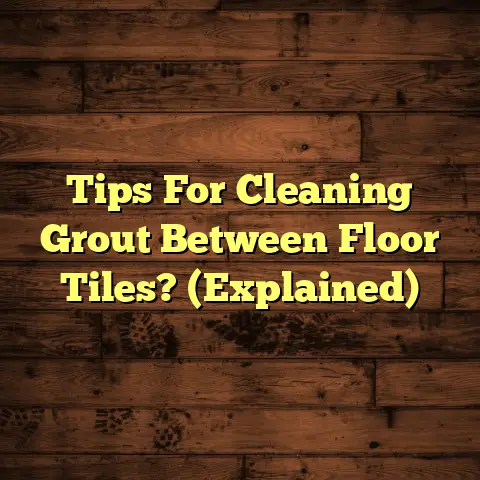Vinyl That Looks Like Wood: Worth It? (5 Key Factors!)
Is it really worth it? Does it look cheap? Will it last?
These are all valid concerns! Choosing flooring is a big deal. It’s not just about aesthetics; it’s about your budget, your lifestyle, and even your peace of mind.
Trust me, I’ve seen it all – from stunning hardwood transformations to disastrous DIY flooring fails.
So, let’s dive into the real deal about vinyl that looks like wood.
I’m going to break down the five key factors I always discuss with my clients to help them make the right choice for their needs. Ready? Let’s get started!
Section 1: Aesthetic Appeal: Does it Really Look Like Wood?
Okay, let’s be honest: this is usually the first thing people ask about.
“Does it really look like wood?”
The answer is: it depends! Technology has come a long way.
Gone are the days of the obviously fake-looking vinyl sheets.
We now have high-definition printing and embossing techniques that can create incredibly realistic textures and patterns.
You can find vinyl that mimics everything from rustic reclaimed wood to sleek, modern oak.
I’ve even seen vinyl that perfectly replicates the grain and knot details of expensive hardwoods like hickory or walnut.
But here’s the catch: Not all vinyl is created equal.
The cheaper stuff? Yeah, it’ll probably look cheap.
Look for terms like “embossed in register” or “enhanced graining.”
These indicate that the texture of the vinyl actually matches the printed image, creating a more realistic feel underfoot.
Think of it like this: would you buy a blurry, low-resolution photo and expect it to look professional?
The same principle applies to vinyl flooring.
Consumer Perceptions & Preferences:
A study by Statista found that visual appearance is among the top factors influencing flooring choices, with 78% of respondents ranking it as “very important.” Statista Flooring Study
So, aesthetics matter.
And while some purists will always prefer the “real deal” of hardwood, many homeowners are increasingly embracing high-quality vinyl for its realistic appearance and other benefits.
What I’ve seen is that people love the idea of hardwood, but then life happens.
Kids spill juice, dogs track in mud, and suddenly that expensive hardwood is looking a little worse for wear.
That’s where the appeal of realistic-looking vinyl really shines. You get the look without the constant worry.
Section 2: Durability and Maintenance: Can it Handle Real Life?
Alright, let’s talk toughness.
Because let’s face it, floors take a beating.
Kids, pets, clumsy adults (guilty!), high heels… it’s a war zone down there!
This is where vinyl really shines compared to traditional wood.
Water Resistance:
This is huge. Hardwood and water? Not friends.
Vinyl is inherently water-resistant, and many options are even waterproof.
That means spills, splashes, and even minor floods are no big deal.
Just wipe them up, and you’re good to go.
I’ve seen countless hardwood floors ruined by leaky appliances or overflowing bathtubs.
Vinyl offers serious peace of mind in moisture-prone areas like kitchens, bathrooms, and basements.
Scratch Resistance:
Another win for vinyl. Most vinyl flooring has a protective wear layer that resists scratches and scuffs.
The thickness of this wear layer is key.
The thicker the wear layer, the more durable the floor will be.
I typically recommend a wear layer of at least 20 mil (that’s 0.02 inches) for high-traffic areas or homes with pets.
Maintenance:
Forget sanding, refinishing, and special cleaning products.
Vinyl is incredibly low-maintenance.
Regular sweeping and the occasional damp mop are usually all it takes to keep it looking its best.
Lifespan:
A well-maintained vinyl floor can easily last 10-20 years, or even longer.
Hardwood can last for decades, but it requires significantly more upkeep to do so.
Statistics & Studies:
According to a report by the Vinyl Institute, vinyl flooring is known for its longevity and resistance to wear, making it a durable option for both residential and commercial use. Vinyl Institute Durability Report
Real-World Experience:
I had one client who was torn between hardwood and vinyl for her kitchen.
She had two young kids and a big, slobbery dog.
I gently steered her towards a high-quality vinyl plank that looked amazing.
A few years later, I ran into her at the grocery store.
She told me the vinyl was the best decision she ever made.
No scratches, no water damage, and easy to clean.
Happy client, happy contractor!
Section 3: Cost-Effectiveness: How Much Will it Really Cost?
Let’s talk money. Because budget is always a factor.
And this is where vinyl often wins big.
Initial Costs:
Generally, vinyl flooring is significantly less expensive than hardwood.
The price per square foot can vary depending on the quality, style, and brand, but you can typically find decent vinyl options for $2-$5 per square foot.
Hardwood, on the other hand, can easily cost $5-$15 per square foot, or even more for exotic species.
Installation Costs:
Installation costs can also be lower for vinyl.
Many vinyl products, especially click-lock planks, are designed for easy DIY installation.
This can save you a significant amount of money on labor costs.
Hardwood installation, on the other hand, is typically best left to the professionals.
It requires specialized tools and expertise, which translates to higher labor costs.
Long-Term Savings:
Remember that low maintenance I mentioned earlier?
That translates to long-term savings.
No need for expensive cleaning products, sanding, or refinishing.
And if a vinyl plank gets damaged, it’s usually easy to replace just that one plank, rather than the entire floor.
Brand & Product Line Comparison:
There are tons of vinyl flooring brands out there, each with its own pros and cons.
Some popular brands include:
- Shaw: Known for its wide variety of styles and durability.
- Armstrong: A long-standing brand with a reputation for quality.
- Lifeproof (Home Depot exclusive): A popular budget-friendly option.
- COREtec: A leader in waterproof vinyl flooring.
I always recommend doing your research and reading reviews before making a decision.
And don’t be afraid to ask for samples!
Seeing and feeling the flooring in person is the best way to get a sense of its quality and appearance.
Budget-Friendly Doesn’t Mean Cheap:
Just because vinyl is more affordable doesn’t mean you have to sacrifice style or quality.
There are plenty of high-end vinyl options that look fantastic and will last for years.
The key is to do your research, choose a reputable brand, and pay attention to the wear layer thickness.
Section 4: Environmental Impact: Is it a Green Choice?
Okay, let’s talk about Mother Earth.
Because increasingly, people are concerned about the environmental impact of their choices.
And that includes flooring.
Sustainability of Vinyl:
Vinyl’s environmental reputation has been a bit mixed over the years.
Traditional vinyl production can involve some environmentally harmful chemicals.
However, things are improving.
Many manufacturers are now using recycled content in their vinyl flooring, and some are even developing bio-based vinyl options.
Eco-Friendly Options:
Look for vinyl flooring that is certified by organizations like FloorScore or GreenGuard.
These certifications indicate that the flooring has been tested for low VOC emissions, which is good for both your health and the environment.
Hardwood’s Impact:
Hardwood flooring also has its environmental impacts.
Deforestation is a major concern, as is the carbon footprint associated with harvesting, processing, and transporting wood.
However, there are sustainable hardwood options available.
Look for wood that is certified by the Forest Stewardship Council (FSC).
This certification ensures that the wood comes from responsibly managed forests.
Comparison:
Ultimately, the environmental impact of vinyl versus hardwood depends on a variety of factors, including the specific product, the manufacturing process, and the sourcing of materials.
Consumer Sentiment:
A recent survey by the National Association of Home Builders (NAHB) found that 64% of home buyers consider eco-friendly products to be important when making purchasing decisions. NAHB Eco-Friendly Survey
So, eco-friendliness is definitely a factor to consider.
My Take:
I always encourage my clients to do their research and choose the most sustainable option that fits their budget and needs.
Look for recycled content, low VOC emissions, and responsible sourcing.
Every little bit helps!
Section 5: Installation Process: Can You DIY It?
Alright, let’s get practical.
How easy is it to install vinyl flooring?
And can you do it yourself?
Ease of Installation:
Compared to hardwood, vinyl is generally much easier to install.
There are several different installation methods, each with its own pros and cons:
- Click-Lock: This is the most popular method for vinyl planks. The planks simply click together, creating a floating floor. It’s relatively easy to install and requires minimal tools.
- Glue-Down: This method involves gluing the vinyl directly to the subfloor. It’s more time-consuming and requires more skill, but it can create a more stable and durable floor.
- Loose Lay: This method uses friction to hold the vinyl in place. It’s the easiest method to install, but it may not be suitable for all areas.
DIY Savings:
DIY installation can save you a significant amount of money on labor costs.
If you’re reasonably handy and have some basic tools, you can probably install click-lock vinyl flooring yourself.
Hardwood Installation:
Hardwood installation, on the other hand, is best left to the professionals.
It requires specialized tools and expertise to ensure a proper and long-lasting installation.
Flexibility:
Vinyl flooring is also very versatile and can be installed in a variety of spaces, including kitchens, bathrooms, basements, and living rooms.
It’s also a good option for renovations, as it can often be installed over existing flooring.
My Advice:
If you’re considering DIY installation, be sure to do your research and watch some instructional videos.
And don’t be afraid to ask for help!
Your local hardware store or flooring supplier can provide valuable advice and guidance.
Conclusion: So, Is Vinyl That Looks Like Wood Worth It?
Okay, we’ve covered a lot of ground!
Let’s recap the five key factors:
- Aesthetic Appeal: High-quality vinyl can look incredibly realistic.
- Durability and Maintenance: Vinyl is tough, water-resistant, and easy to clean.
- Cost-Effectiveness: Vinyl is generally more affordable than hardwood.
- Environmental Impact: Look for sustainable vinyl options with recycled content and low VOC emissions.
- Installation Process: Vinyl is relatively easy to install, and many options are DIY-friendly.
So, is vinyl that looks like wood worth it?
The answer, as always, is: it depends!
It depends on your budget, your lifestyle, your aesthetic preferences, and your environmental concerns.
If you’re looking for a beautiful, durable, and affordable flooring option that’s easy to maintain, then vinyl is definitely worth considering.
But do your research, choose a reputable brand, and don’t be afraid to ask for help!
And remember, the best flooring choice is the one that meets your needs and makes you happy.
Happy flooring!





